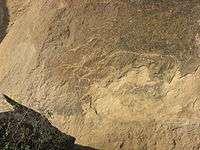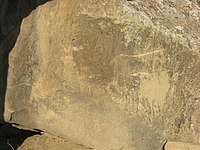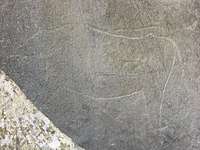Gobustan Rock Art
Gobustan Rock Art represents flora and fauna, hunting, lifestyles, and culture of pre-historic and medieval periods of time.[1] The carvings on the rocks illustrates primitive men, ritual dances, men with lances in their hands, animals, bull fights, camel caravans, and picture of the sun and stars. The date of these carvings goes back to 5.000 – 20.000 years before.[2]
| UNESCO World Heritage Site | |
|---|---|
 Petroglyphs on rock in Gobustan | |
| Location | Azerbaijan |
| Criteria | iii |
| Reference | 1076 |
| Inscription | 2007 (31st session) |
Gobustan Rock Art Cultural Landscape
The Gobustan Rock Art Cultural Landscape represents the history of humanity from the Upper Paleolithic era to the Middle Ages in Eurasia.[3] It is situated at the south-east end of the Greater Caucasus ridge in Azerbaijan. it is located approximately 64 km away from center of Baku. The area of the site is 537 ha.[4]
The cultural landscape covers three rocky highlands in the semi-desert territory of central Azerbaijan. There are more than 6.000 rock engravings on more than 1.000 surfaces of rocks that reflects 40.000 years of history of rock art.[5][4][6]
During the archaeological excavation, 104 small-sized engraved stones were also discovered at different archaeological stages[3]
Petroglyphs in Gobustan dating about 5,000 to 8,000 years back contain longships similar to Viking ships.[7][8] The discovery of ship illustrations among the rock paintings in Gobustan shows its relationship with the Mediterranean and the European continent.[9]
Jingirdag, Boyukdash, and Kichikdash mountains and Yazili hill are located in Gobustan, which are the home for the ancient rock art. Most of the rock carving can be found on the upper surface of Boyukdash and Kicikdash mountains. The paintings on the rock walls date back to 3-4 thousand years ago mainly reflect hunting scenes. Human (dancers, hunters, men wearing tropical helmets) and animal (deer and goat) paintings are depicted on the rocks of more sheltered sides.[10]
Images of animals on Gobustan rocks vary depending on the periods because of the change in the hunting targets (from big animals like aurochs and wild horses (during the Pleistocene period) to relatively smaller Holocene animals such as deer, wild boar and bird) according to the climate change starting at the beginning of the Holocene period.[3]
The petroglyphs on the walls of the living sites as “Firuz-1”, “Firuz-2”, “Gaya-arasi”, “Gaya-Arasi-2” on Kicikdash Mountain, “Kaniza”, “Ana-Zaga” on Boyukdash Mountain are similar to the petroglyphs on some stones in this site. [3]
One of the rocks has a Latin inscription belonging to the period of Roman Emperor Domitian’s reign (81-96 AD), which shows the temporary stay of the 12th Roman Legion led by Fulminate on the Caspian shores. [7]
Another remnant of the early time is so-called "gaval chalan dash" (tambourine stone), an ancient musical instrument described in Gobustan Rock Art.[7]
In 1996, by the decree of the Council of Ministers of Azerbaijan SSR, the mountains were declared as Gobustan State Historical Artistic Preserve. By the decree of the president, the mountains were declared as National Reserve in 2007.[4]
For its quality and density of rock art engravings, Gobustan was declared as a UNESCO World Heritage Site in 2007.[4][11]
History
The cultural landscape was firstly discovered by local miner in 1939-40.[12][2] The sticky drawings of the deer, goat and cattle dated between 12th and 8th centuries BC reflect the Neolithic period in Gobustan.[13] Gobustan petroglyphs studied by Isak Jafarzadeh who analyzed approximately 750 rocks with more than 3.500 petroglyphs in 1947 and onwards were divided into 6 periods from ancient times to the Middle Ages:
- Neolithic period (figures contain men and women drawings with arrow and bow on their shoulders),
- Late Neolithic period (drawings of bison, boat, and archers),
- Eneolithic period (big drawings of goats, lions and deer),
- Bronze Age period (wild animals, horses and pigs drawings),
- Iron Age period (man drawings, goats and deer figures, as well as Roman inscriptions)
The Middle Ages (camel caravans drawings, a warrior with a weapon on his hand, symbols, Arabic and Persian inscriptions).[14]
Later on, F. Muradova and J. Rustamov made new discoveries of more than 1.500 images. During the archaeological excavation, numerous Bronze Age structures were found here.[3] Those archaeological excavations were supported by the Institute of Archeological and Ethnography of the National Academy of Science of Azerbaijan.[12]
In 1966, 1988 and 2001, all discoveries of rock carvings and images were taken under state protection.[12]
Gallery
- Petroglyphs on rocks in Gobustan

_from_that_era_(37074580146).jpg)


See also
- Gobustan District
- Gobustan National Park
- World Heritage site
References
- Centre, UNESCO World Heritage. "Gobustan Rock Art Cultural Landscape". whc.unesco.org. Retrieved 2018-09-11.
- "Gobustan Rock Art - Unesco World Heritage Site | For World Heritage Travellers". www.worldheritagesite.org. Retrieved 2018-09-11.
- Gobustan Rock Art Cultural Landscap -el paisaje cultural del arte rupestre de Gobustán (2016). "Gobustan Rock Art Cultural Landscape" (PDF). Cuadernos de Arte Rupestre: 213–232.
- "Gobustan Rock Art, AZERBAIJAN - Med-O-Med". Med-O-Med. Retrieved 2018-09-12.
- Sagona, Antonio (2017). The Archaeology of the Caucasus: From Earliest Settlements to the Iron Age. Cambridge University Press. ISBN 1107016592.
- "Gobustan Rock Art - Unesco World Heritage Site | For World Heritage Travellers". www.worldheritagesite.org. Retrieved 2018-09-12.
- "The Rock Engravings of Gobustan". donsmaps.com. Retrieved 2018-12-03.
- Pre-Columbian Trans-Oceanic Contact. Lulu.com. 2016. p. 98. ISBN 9781329972162.
- Cognitive Archaeology as Symbolic Archaeology. England: Archaeopress, Publishers of British,Archaeological Reports. 2008. p. 32. ISBN 9781407301792.
- Azerbaijan: Mosques, Turrets, Palaces. Corvina Kiadó. 1979. p. 8. ISBN 9789631303216.
- Matthew, Vincent; Bendicho, Víctor; Ioannides, Marinos; Levy, Thomas (2017). Heritage and Archaeology in the Digital Age: Acquisition, Curation, and Dissemination of Spatial Cultural Heritage Data. Springer. ISBN 3319653709.
- Gobustan Rock Art Cultural Landscape. World Heritage Site Nomination Document
- The sticky drawings of the deer, goat and cattle dated between 12th and 8th centuries BC reflect the Neolithic period in Gobustan. Rosen Pub Group. 2004. p. 11. ISBN 0823944972.
- "Pleistocene art in Azerbaijan" (PDF).